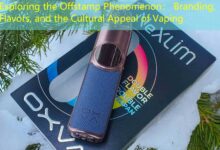The Rise of VG and PG in Vaping
In recent years, the popularity of vaping has surged dramatically, drawing attention to the essential components that make up e-liquids. Among these, Vegetable Glycerin (VG) and Propylene Glycol (PG) play pivotal roles. Understanding the differences, benefits, and best applications of VG and PG is crucial for both new and experienced vapers.
What Are VG and PG?
Vegetable Glycerin is a natural substance derived from vegetable oils, known for its thick consistency and sweet flavor. On the other hand, Propylene Glycol is a synthetic compound commonly used in food, cosmetics, and pharmaceuticals. Both VG and PG serve distinct purposes in e-liquids, and their unique properties cater to different preferences in the vaping community.
The Benefits of VG
One of the key advantages of VG is its ability to produce thick vapor clouds, which is why it is favored by cloud chasers. Additionally, VG is vegetable-derived, making it a preferred option for those seeking a more natural vaping experience. It’s also known for its smoother throat hit, making it suitable for users who might find PG irritating. Many e-liquid manufacturers use a higher VG ratio to enhance the overall vaping experience.
The Role of PG
Propylene Glycol is best known for its ability to deliver a strong throat hit, similar to traditional tobacco smoking. This quality makes it a popular choice for those transitioning from cigarettes to vaping. PG also acts as a flavor carrier, enhancing the taste of the e-liquid. However, some users may experience sensitivities to PG, prompting them to seek VG-based alternatives.
Finding the Right Ratio
The ideal VG/PG ratio largely depends on personal preference and the desired experience. For instance, a 70/30 VG/PG blend is often recommended for users who prioritize vapor production while still enjoying flavor and throat hit. In contrast, a 50/50 blend is suitable for those who want a balanced experience.
Case Study: User Preferences
Let’s consider a hypothetical case study of two vapers: Alex, who prefers cloud chasing, and Jamie, who prefers robust flavors. Alex opts for a high VG blend (80/20), yielding large vapor clouds while maintaining smoothness. Conversely, Jamie chooses a high PG blend (70/30) for enhanced flavor and a pronounced throat hit. This illustrates how VG and PG can cater to diverse vaping styles.
The Future of VG and PG in E-liquids
The ongoing innovation in e-liquids suggests a promising future for the use of VG and PG. As more vapers become health-conscious, the demand for natural and organic ingredients is rising. Consequently, manufacturers are leaning towards high VG formulations without compromising on flavor. This trend not only enhances the vaping experience but also addresses growing consumer preferences.

Conclusion
In summary, VG and PG are integral to the vaping experience, appealing to different tastes and preferences. Whether you’re after large vapor clouds or an intense flavor profile, understanding these two components can significantly enhance your vaping journey.
| Type | VG | PG |
|---|---|---|
| Source | Vegetable Oils | Synthetic compound |
| Throat Hit | Smoother | Stronger |
| Vapor Production | Higher | Lower |
| Flavor Strength | Less | More |







